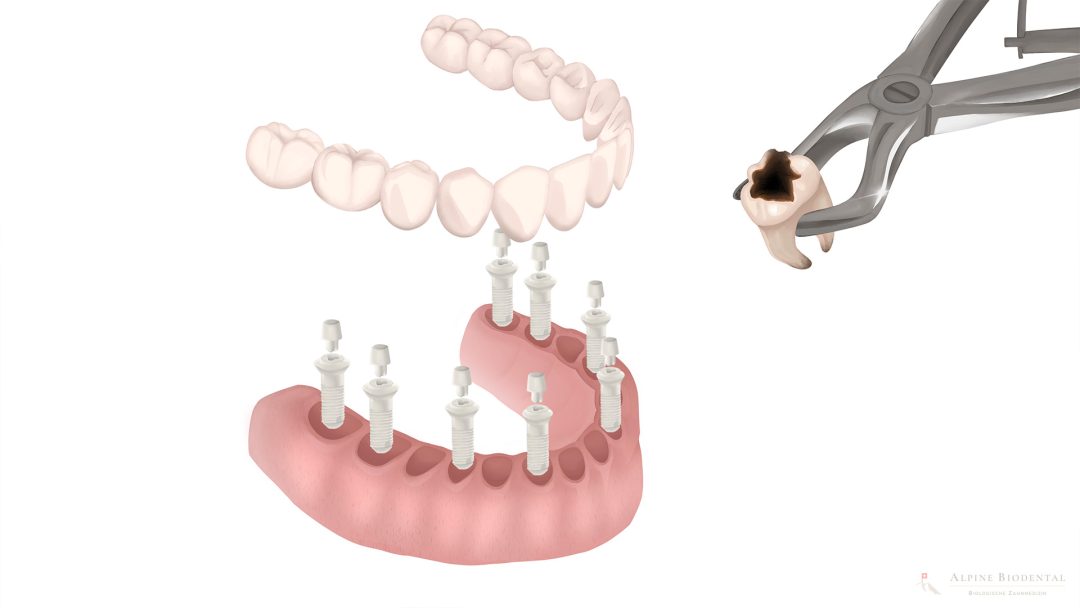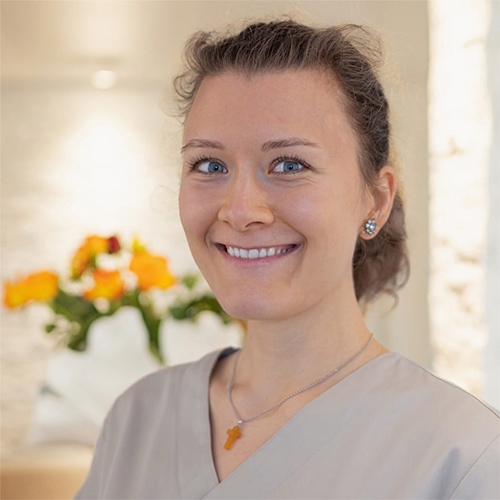Fixed Teeth in one Day

Getting fixed teeth in one day is the wish of many toothless patients. Because fixed teeth mean an enormous gain in quality of life.
There are various fixed alternatives to the classic full denture.
In this article, you will learn about the procedure that we recommend and carry out in our dental practice.
Diagnostic with Cone Beam Computed Tomography (CBCT)
In order to carry out accurate planning and diagnostics, it is essential to have a precise and dimensionally accurate representation of the jawbone. Radiological imaging with Cone Beam Computed Tomography (CBCT) proves highly advantageous, providing three-dimensional information about the jawbone.
The CBCT reveals the following crucial information:
- Bone availability in vertical and horizontal directions.
- Bone quality and density.
- Space proximity to the maxillary sinuses and nerves in the lower jaw and palate.
- Presence of scattered foreign bodies in the bone and gums, such as amalgam fragments, root remnants, or overcompressed paste from previous root canal treatments.
Digital measurements of exact distances can be taken and transferred to the patient’s anatomy. This enables precise placement of implants and optimal utilization of the jawbone.
Backward Planning
Backward planning involves determining the desired end result for the patient and building the entire plan accordingly.
The goal is a fixed dental restoration with the following requirements:
- Aesthetic outcomes should be natural and complement the patient's appearance. They should have natural and beautiful teeth after treatment.
- The dental prosthesis should ideally support all anatomical structures such as lips and cheeks, making the patient look younger and healthier.
- Occlusal height and bite contacts should be anatomically correct. The bite height and position significantly affect the patient's appearance, so a youthful and natural look is sought after.
- The temporomandibular joints should be in an ideal position, in harmony with the entire body, positively influencing body posture.
To ensure this ideal outcome, various steps are necessary:
- Impressions of the upper and lower jaws and the creation of models in the in-house dental laboratory.
- Analysis of the position of the upper jaw and temporomandibular joints using the Zebris system.
- Recording of the correct bite position by means of correct coding of the jaws for the dental technician.
- The dental technician uses this information to create a wax mock-up. This forms the basis for the exact position of the implants and the subsequent plastic temporary restoration.
As evident, achieving an ideal result requires extensive experience from both dentists and dental technicians, with the entire team working seamlessly together.
The dental laboratory within the practice allows each step to be ideally coordinated, resulting in the best possible outcome.
Ceramic Implants – Minimum of 8 per Jaw
In our dental practice, dentists exclusively utilize ceramic implants, as they are preferred from both health and biological perspectives.
To provide a stable and durable tooth replacement for a toothless jaw, a minimum of 8 dental implants is necessary. The All-on-4 concept quickly reaches its limitations and is not recommended.
If anatomical conditions permit, more ceramic implants can be inserted, ideally replacing each lost tooth, mirroring the natural state of a healthy dentition.
Surgery Day – Fixed Teeth in One Day
Patients in our practice receive the desired fixed teeth on the same day. For completely edentulous patients, a total of at least 16 ceramic implants are required.
The operation is performed exclusively under local anesthesia, similar to procedures for fillings. However, general anesthesia can be administered for patients with dental anxiety, severe gag reflex, or other relevant reasons.
Based on prior diagnostic work with CBCT and the Backward Planning approach, implants can be positioned optimally.
All steps for optimal implant integration are undertaken, including atraumatic surgical techniques, the use of A-PRF (Advanced Platelet-Rich Fibrin), and ozone therapy.
After implant placement, the patient receives carefully planned provisional restorations, cemented onto the implants, which remain in the mouth for 3 months.
Definitive Ceramic Prosthetics
Approximately 3 months later, the long-term provisional restorations made of plastic are removed, and the patient receives the definitive ceramic crowns and ceramic bridges.
Due to prior Backward Planning, the new prosthetics fulfill all desired and pre-planned objectives. Jaw joints are in an ideal position, supporting the patient’s soft tissue profile anatomically and harmoniously. The prosthetics appear natural and indistinguishable from natural teeth. Additionally, all tooth contacts are adjusted anatomically for even force distribution and comfortable chewing.
For cases where 8 implants were placed per jaw, the definitive prosthetics consist of four ceramic bridges.
If more implants are desired, ceramic crowns are used, similar to natural teeth, cemented onto the ceramic implants.
Follow-up Care and Longevity
Our goal is to ensure that the created prosthetics last a lifetime and that there is no occurrence of peri-implantitis or implant loss.
Bacterial Flora
The foundation for longevity lies in a healthy bacterial flora in the oral cavity. A healthy oral flora not only has health benefits but also prevents premature loosening of ceramic implants in such dental restorations. Therefore, building a healthy oral flora is crucial.
Vitamin D3
Additionally, it is crucial to prevent a deficiency in Vitamin D3. A low Vitamin D3 level can negatively impact bone metabolism, increasing the risk of implant loss. In our dental practices, we can perform on-site Vitamin D testing.
aMMP8
aMMP8 is an enzyme produced by immune cells that accelerates tissue breakdown. Its production increases when immune cells come into contact with oral bacteria, leading to an enhanced breakdown of bone and potential development of periodontitis. Regular periodontitis diagnostics in the practice can be beneficial to identify such issues promptly, preventing implant loss.
It is advisable to have periodontitis diagnostics carried out regularly in the practice.
Dr. Josephine Phillips
Firm teeth are crucial for a good quality of life and a strong bite. Our specialists will be happy to help you.

FAQ
There are many people who wear dentures and long for fixed teeth with all their advantages.
This step brings a lot of quality of life and health for those affected.
In addition, the external appearance also improves because the ideal bite with the anatomically correct facial shape can be restored.
You can expect to pay around CHF 5000 to 6000 per dental implant.
Yes, with the All-on-4 method, a fixed denture can be anchored to the implants. As this procedure has various disadvantages, we do not offer All-on-4 in our dental practice.
We try to avoid bone augmentation as far as possible. However, if severe bone resorption has occurred, such a procedure is necessary together with the implantation. If necessary, only the patient’s own bone is used.
Yes, our dentists are very experienced and can solve every case with the best possible result. However, in complicated situations and with pronounced bone recession, it may be necessary to proceed in several steps.
Further information
The further information is intended to give you a better overview of the subject area.